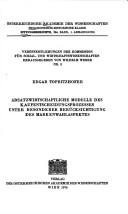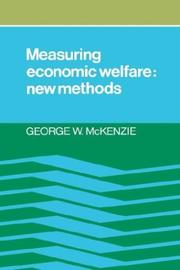| Listing 1 - 10 of 14 | << page >> |
Sort by
|
Book
ISBN: 0486848434 Year: 2020 Publisher: Newburyport : Dover Publications,
Abstract | Keywords | Export | Availability | Bookmark
 Loading...
Loading...Choose an application
- Reference Manager
- EndNote
- RefWorks (Direct export to RefWorks)
This thought-provoking and influential book by a distinguished economist examines whether consumption behavior can be defined in a way that's supported by empirical evidence and useful for research and planning.

ISBN: 0444863125 9780444863126 Year: 1981 Volume: 30 Publisher: Amsterdam North-Holland
Abstract | Keywords | Export | Availability | Bookmark
 Loading...
Loading...Choose an application
- Reference Manager
- EndNote
- RefWorks (Direct export to RefWorks)

ISBN: 3700100809 9783700100805 Year: 1974 Volume: 294/1 3 Publisher: Wien Österreichische Akademie der Wissenschaften
Abstract | Keywords | Export | Availability | Bookmark
 Loading...
Loading...Choose an application
- Reference Manager
- EndNote
- RefWorks (Direct export to RefWorks)
Book
ISBN: 3261015829 9783261015822 Year: 1975 Volume: 233 Publisher: Francfort : H. Lang,
Abstract | Keywords | Export | Availability | Bookmark
 Loading...
Loading...Choose an application
- Reference Manager
- EndNote
- RefWorks (Direct export to RefWorks)
Book
ISBN: 2040032568 9782040032562 Year: 1975 Volume: 51 Publisher: Paris Dunod
Abstract | Keywords | Export | Availability | Bookmark
 Loading...
Loading...Choose an application
- Reference Manager
- EndNote
- RefWorks (Direct export to RefWorks)
Econometrics --- Consumption (Economics) --- Mathematical models --- Économétrie --- Modèles économétriques --- Économétrie --- Modèles économétriques --- Consumption (Economics) - Mathematical models --- Econometrie appliquee
Book
ISBN: 0745000827 9780745000824 Year: 1987 Publisher: Brighton
Abstract | Keywords | Export | Availability | Bookmark
 Loading...
Loading...Choose an application
- Reference Manager
- EndNote
- RefWorks (Direct export to RefWorks)
National consumption --- Consumption (Economics) --- Mathematical models --- AA / International- internationaal --- 339.320 --- Consumptie: algemeenheden. Wet van de vraag in verband met de consumptie. Consumptiebehoefte. Behoeftetheorie. --- Consumptie: algemeenheden. Wet van de vraag in verband met de consumptie. Consumptiebehoefte. Behoeftetheorie --- Consumption (Economics) - Mathematical models

ISBN: 0521606195 0521781264 0511118651 0511018789 0511156650 0511329342 0511510640 128015912X 0511045999 9780511018787 9780511510649 9780511156656 9780511118654 9780511045998 9781280159121 9780521781268 9780521606196 1107120306 Year: 2002 Publisher: Cambridge Cambridge University Press
Abstract | Keywords | Export | Availability | Bookmark
 Loading...
Loading...Choose an application
- Reference Manager
- EndNote
- RefWorks (Direct export to RefWorks)
This book has two components: stochastic dynamics and stochastic random combinatorial analysis. The first discusses evolving patterns of interactions of a large but finite number of agents of several types. Changes of agent types or their choices or decisions over time are formulated as jump Markov processes with suitably specified transition rates: optimisations by agents make these rates generally endogenous. Probabilistic equilibrium selection rules are also discussed, together with the distributions of relative sizes of the bases of attraction. As the number of agents approaches infinity, we recover deterministic macroeconomic relations of more conventional economic models. The second component analyses how agents form clusters of various sizes. This has applications for discussing sizes or shares of markets by various agents which involve some combinatorial analysis patterned after the population genetics literature. These are shown to be relevant to distributions of returns to assets, volatility of returns, and power laws.
AA / International- internationaal --- 305.971 --- Speciale gevallen in econometrische modelbouw. --- Consumption (Economics) - Mathematical models. --- Demand (Economic theory). --- Consumption functions (Economics) --- Demand (Economic theory) --- Supply and demand --- Consumption (Economics) --- Business cycles --- Statics and dynamics (Social sciences) --- Stochastic processes --- Mathematical models --- Demanda (Teoría económica) --- modelos matemáticos --- Oferta y demanda --- modelos matemáticos. --- Consumo (Economía) --- Ciclos económicos --- Modelos matemáticos. --- E-books --- Mathematical models. --- Speciale gevallen in econometrische modelbouw --- Business, Economy and Management --- Economics

ISBN: 0521248620 0521035945 0511571771 9780521248624 9780511571770 9780521035941 Year: 1983 Publisher: London Cambridge University Press
Abstract | Keywords | Export | Availability | Bookmark
 Loading...
Loading...Choose an application
- Reference Manager
- EndNote
- RefWorks (Direct export to RefWorks)
Professor McKenzie proposes and formulates a method composed of operational procedures designed to facilitate the evaluation of economic projects and policies. This method is discussed fully, illustrated by simple examples, and compared with alternative procedures. An outline of a computer program that enables readers to undertake their own calculations is included. In order to present the approach clearly, the author provides an exposition of the fundamental ideas and the main alternative approaches to the problem. These rely on various forms of index numbers and consumer surplus. However, as is well known, such measures are not capable of correctly ordering the various alternatives under consideration, except under highly unrealist assumptions. In this book the author suggests the abandonment of this traditional approach based on the concept of 'willingness-to-pay' or the conpensating variation. Instead, the measure that Samuelson has called the 'money-metric' should become the cornerstone of applied welfare economics.
Microeconomics --- Welfare economics --- Consumption (Economics) --- Demand functions (Economic theory) --- Mathematical models --- economie --- prosperite et bien etre --- modeles economiques --- AA / International- internationaal --- 306.110 --- 339.320 --- 330.580 --- welvaart en welzijn --- economische modellen --- Algemeenheden over indexcijfers. --- Consumptie: algemeenheden. Wet van de vraag in verband met de consumptie. Consumptiebehoefte. Behoeftetheorie. --- Gecontroleerde economie. Geleide economie. Welvaarststaat. Algemeenheden. --- Economic policy --- Economics --- Social policy --- Demand curves (Economic theory) --- Functions, Demand (Economic theory) --- Consumption functions (Economics) --- Algemeenheden over indexcijfers --- Gecontroleerde economie. Geleide economie. Welvaarststaat. Algemeenheden --- Consumptie: algemeenheden. Wet van de vraag in verband met de consumptie. Consumptiebehoefte. Behoeftetheorie --- Business, Economy and Management --- Consumption (Economics) - Mathematical models --- Welfare economics. --- Mathematical models.
Book
ISBN: 0669863149 9780669863147 Year: 1974 Publisher: Lexington Heath
Abstract | Keywords | Export | Availability | Bookmark
 Loading...
Loading...Choose an application
- Reference Manager
- EndNote
- RefWorks (Direct export to RefWorks)
Consumption (Economics) --- Mathematical models --- 64.032 --- 659 --- -Consumption functions (Economics) --- Consumer needs, research and advice generally. Quality and costs of household goods. Comparison of prices etc. --- Publicity. Information work. Public relations --- Mathematical models. --- -Consumer needs, research and advice generally. Quality and costs of household goods. Comparison of prices etc. --- 659 Publicity. Information work. Public relations --- 64.032 Consumer needs, research and advice generally. Quality and costs of household goods. Comparison of prices etc. --- Consumption functions (Economics) --- Consumer needs, research and advice generally. Quality and costs of household goods. Comparison of prices etc --- Basic Sciences. Mathematics -- Mathematical Models, Simulation Models --- ALLW. --- Consumption (Economics) - Mathematical models
Book
ISBN: 3642329667 3642446302 3642329675 1283935228 Year: 2013 Publisher: Heidelberg : Physica-Verlag,
Abstract | Keywords | Export | Availability | Bookmark
 Loading...
Loading...Choose an application
- Reference Manager
- EndNote
- RefWorks (Direct export to RefWorks)
This book studies the sustainability and optimality of public debt under different scenarios: the closed economy, the small open economy, and a two-country setting. Sustainability refers to the existence and the stability of the long-run equilibrium. Optimality relates to the path of public debt that maximizes discounted utility. The analysis is conducted within the framework of the Solow model, the overlapping generations model and the infinite horizon model. The government can follow different strategies, it either fixes the deficit ratio or the tax rate. As a result, a fixed deficit ratio generally can be sustained. By contrast, a fixed tax rate generally cannot be sustained. Depending on the chosen fiscal strategy, there exists either an optimal deficit ratio or an optimal tax rate that maximizes the sum of consumption and government purchases per capita.
Consumption (Economics) -- Mathematical models. --- Debts, Public -- Mathematical models. --- Debts, Public. --- Debts. --- Finance. --- Debts, Public --- Political Science --- Law, Politics & Government --- Public Finance --- Mathematical models --- Mathematical models. --- Macroeconomics. --- International economics. --- Public finance. --- Economic growth. --- Economics. --- Public Economics. --- Economic Growth. --- International Economics. --- Macroeconomics/Monetary Economics//Financial Economics. --- Economics --- Economic policy, Foreign --- Economic relations, Foreign --- Economics, International --- Foreign economic policy --- Foreign economic relations --- Interdependence of nations --- International economic policy --- International economics --- New international economic order --- Economic policy --- International relations --- Economic sanctions --- Development, Economic --- Economic growth --- Growth, Economic --- Statics and dynamics (Social sciences) --- Development economics --- Resource curse --- Cameralistics --- Public finance --- Currency question --- Public finances
| Listing 1 - 10 of 14 | << page >> |
Sort by
|

 Search
Search Feedback
Feedback About UniCat
About UniCat  Help
Help News
News